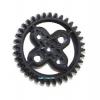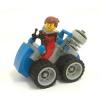Search the Community
Showing results for tags 'ev3'.
Found 184 results
-
For the large candy container warehouse that I am building (click here to read more details), I need three more builds: A candy feeding mechanism. I need a mechanism that feeds one candy at a time to a conveyor belt. Color detection. The color of the candy needs to be determined. Systems that puts the candy into a container. The container can then be conveyed to the warehouse where it can be stored sorted by color. The color as determined in step 2, needs to be passed to the warehouse brick so it can store the container on the right level. Color detection (step 2) I started with step 2. To realize the candy sorter, I needed to know if a Pixycam (see www.charmedlabs.com/default/pixy-lego/) can distinguish the colors of the candy. The colors are not bright (like the Lego bricks), so I wasn't sure if it was possible. I created a quick setup to test the color detection: Next, I placed the four different candies (Fruit-tella) on the conveyor belt and programmed the camera for the four colors. This is the image of the camera, from left to right: (1) raw video, (2) cooked video (= mix of raw video + color detection) and (3) detection only video. Finally, I made a simple test EV3 program. With the addition that the detected block should be more than 20 pixels in width, it detects the candies in the correct color. Candy feeding mechanism Ok, so I have a conveyor belt with a candy on it. But how do I get the candy, one by one, on the conveyor belt. This is where the feeder comes in. I searched the internet for 'real life' solutions. I found out that a rotary feeder or bowl feeder would do best. I tried to make a vibratory bowl feeder (out of 16 circle gear rack elements 24121), but that didn't work. However, rotating the bowl seemed to work so I made a prototype based on rotation and gravity. The bowl is placed at an angle of +/- 20 degrees and then it just rotates in a steady pace. The result was good: it never happened that two candies were fed to the conveyor at the same time. The next step is to make a more solid version and add the color detection unit to it. I'll keep you posted. Enjoy, Hans
-

45544 Colour Sorter Tensorflow mod with Raspberry Pi
ebswift posted a topic in LEGO Technic, Mindstorms, Model Team and Scale Modeling
Here's something a little different, I needed a sorting machine using Tensorflow, Raspberry Pi and EV3 (with RPyc), so 45544 fit the bill pretty nicely. The project took a couple of weeks to get up and running mostly due to having no exposure to either EV3, Tensorflow or RPyC, but it is definitely achievable with some shoe-horning here and there. Don't hate my LEGO extension to the 45544 sorter too much, it was quick and nasty, the project isn't about the elegance of that side of things, it is more about making an end result that works doing something the EV3 can't on its own. And work it does, it is able to reliably discern 4 image types stuck onto 3D printed tiles (in place of the technics bricks). In the shorter term I will design and 3D print a support structure to hold the Raspberry Pi + camera. That part will be done using driven design workflow in Autodesk Inventor, feeding in known LEGO brick dimensions for quick & easy parts alignment. In the longer term I can see the addition of a vibratory bowl feeder with tiles being recycled after sorting for continuous operation. Right now it is a technology demonstrator that will be used to introduce school children to some modern technology, I should be able to complete a design manual for them to replicate my working design. Check it out if you're at all interested in controlling the EV3 externally to greatly expand its functionality: https://www.youtube.com/watch?v=wSSh9iV70ng- 2 replies
-
- raspberry pi
- ev3
-
(and 1 more)
Tagged with:
-

Skat3r - the robot with a Rocker-Bogie mechanism
andreasbaumgart posted a topic in LEGO Technic, Mindstorms, Model Team and Scale Modeling
Hello, actually i am working on an small robot, who is able to climb about obstacles.This is the current version.- 3 replies
-
- lego mindstorms
- rocker bogie
-
(and 2 more)
Tagged with:
-

[MOC] Giant LEGO F1 Car
TheMindGarage posted a topic in LEGO Technic, Mindstorms, Model Team and Scale Modeling
Yes, this is a giant F1 car. It's around 1.2 metres long and large enough to sit in. The main features: Pedal-driven rear wheels 8-speed sequential transmission shifted via paddles on steering wheel Rear disk brakes activated by button on steering wheel Electronically-controlled limited-slip differential Rack and pinion steering connected to steering wheel Display showing pedal RPM, gear and wheel speed The car uses MINDSTORMS EV3 to operate the functions. It uses one standard EV3 set's worth of electronics plus an additional Large motor. The gearbox is a 4-speed design expanded with a close-ratio 2-speed (ratios 1:1 and 1:1.2) giving 8 speeds in total. A single motor controls it - each gear requires 180 degrees of rotation. Rotating by 90 degrees puts the gearbox in neutral. A Geneva mechanism is used to control the 4-speed - when the 2-speed goes from the high gear to the low gear, the 4-speed is advanced one gear. This is how it shifts from gear 2 to gear 3. In order to reduce the amount of torque handled by the gearbox, it is geared up very highly. This increases friction and reduces efficiency, but there is no shortage of power (I calculated a human’s power output at over 100 EV3 Large motors!). The limiting factor here is how much torque the parts can handle. The disk brakes use a 49mm tyre as the disk and red rubber pads from the EV3 Expansion set. There are two sets of callipers on each wheel (4 pads per wheel in total) giving huge stopping power. A rather complex linkage allows a single input to control both sets of callipers at the same time. An EV3 Large motor pulls on the beam which activates the brakes via a bell-crank linkage. There are two brake motors so the EV3 can operate them independently - this is important for the next step. The differential is very ruggedly-built to prevent gear slippage or parts breaking. An extra small differential measures the speed difference between the two outputs - this goes to a Medium motor used as a rotation sensor. This allows the percentage differential slip to be calculated - if it exceeds a certain limit, the faster wheel is braked slightly (via the disk brakes) to give more torque to the slower one. The clutch ring is manually operated by a switch under the steering wheel- when engaged, it locks the output to zero, making the differential operate as a solid axle. This is a very similar system to the one used on the million-dollar McLaren P1 hypercar. The wheels are made from tank tread links bent backwards into a tight loop. Not sure if this is considered a "legal" solution, but it works very well. The front wheels have 42 links and the rears have 48. The rear wheels have very tight spokes in order to allow them to take the massive weight of the driver. The wheels started gaining camber (tilting) and falling off under load, so I added extra support on the other side of the wheel. The beams are set up to be under tension to push the wheel towards the axle and prevent it from falling off. The rear section uses many layers of beams and frames to make it strong enough to withstand the weight of the driver. Extra diagonal beams (the white ones) are added - they are positioned in a perfect 3:4:5 Pythagorean triple to avoid having them under compression or tension. I used a Warren truss for the central structure - that bit is virtually indestructible. The front section doesn’t look very strong, but the extra vertical beams allow it to withstand plenty of load. The chassis is very sturdy, but with a driver on board, it tends to bend quite a bit and suffers from some serious body roll issues. The steering uses a rack-and-pinion system with just over half a turn from lock-to-lock. This is similar to the steering ratio used on F1 cars. Two large custom-built universal joints are used for the steering shaft. The shaft is reinforced to prevent torsion - even a little twisting would result in inaccurate, floppy steering. The steering wheel is made to look like an F1 wheel. The two rear paddles are for the gears - right for shifting up, left for down. The front left paddle activates neutral gear when held - as soon as it is released, the transmission returns to the last gear selected. The front right paddle activates both brakes simultaneously. Each paddle presses a button on the EV3 infrared remote which is in the middle of the steering wheel. Its signal shines through the turntable and is captured by the IR receiver on the other side. This allows signals from the steering wheel to reach the EV3 brick wirelessly. The paddles have a very short throw and a crisp feel - they’re one of my favourite parts of the car. The car has a full display with features like an RPM bar and wheel speed shown (since the wheels have very little grip and are liable to doing burnouts, actual speed will be quite different). The gear number is also shown. The RPM is measured by a touch sensor and a cam connected to the pedals. The cam bumps the touch sensor every 1/7th turn of the pedals. I initially tried to use a Colour sensor to detect the black chain links against the greys but the difference in reflected light was insufficient for it to be reliable. Strength-wise, the chassis can easily deal with 20kg on the seat. Perhaps it would be ideal for a 6-year-old gearhead. Unfortunately, I'm a lot more than 20kg, so I kind of broke it. Here's the aftermath: Here's a video of me explaining and demonstrating the features of the car. You can also skip to 10:56 to see me try out the car... [All music is composed by me. My F1 V10 impression is not edited in any way!] In the end, I think it was a successful experiment. I intended this MOC to be a testbed for various ideas I had, and you might possibly see a scaled-down version of some of the mechanisms (such as the differential) in a normal-sized car of mine in the future. After all, that's why real-life car manufacturers build concepts and sell low-volume cars at a loss. If it wasn't for that, we wouldn't have the Bugatti Veyron, Pagani Zonda R, Lexus LFA and other amazing machines. -

6 Li-PO AA to be used in Ev3 Mindstorms
Serg posted a topic in LEGO Technic, Mindstorms, Model Team and Scale Modeling
Hello All Sorry if this question was already raised! As you all know Lego Rechargeable Battery for ev3 is expensive. May I ask you if anyone tried to use 6 Li-Po 1.5v rechargeable batteries there instead of regular lithium Batteries? Ni-MH are all 1.2v , and will not work as needed but maybe 1.5 li-po would be Ok ? Brand, let say : ZNTER They can be found on ebay for $40 for 6 batteries ... http://www.ebay.com/itm/6pcs-ZNTER-1-5V-AAA-400mAh-LiPo-rechargeable-lithium-battery-USB-charging-line-/272099707530?hash=item3f5a680a8a:g:RQ8AAOSwX~dWkQt- or http://www.bestbuy.com/site/eco-cell-usb-cell-rechargeable-aa-batteries-4-pack-white-green/4471800.p?skuId=4471800 Thank you !!! -

Perpendicular gearage
ruperty posted a topic in LEGO Technic, Mindstorms, Model Team and Scale Modeling
Hi, I am trying to model a leg, with a knee and ankle joint, as can be seen in the image with the two motors at the joints. I intend for it to stand up by itself based on the accelerometer reading. However, I don't think the design is very good and would put too much exertion on the motors. I believe a better alternative would be to use worm gears, which I do actually have at the top of the picture to manually change the angle of the accelerometer. So I would like to replace the motor system with a worm gear turned by the motor. However, this is also going to require gears to turn the direction of rotation by 90 degrees. Can anyone suggest the best and most robust way to do this? It would be great if you could let me know what parts would be required for the perpendicular gearage, and the work gearage. I have three Lego EV3 Mindstorms sets. -

[EV3] Fully Automated Candy Warehouse
Hanso posted a topic in LEGO Technic, Mindstorms, Model Team and Scale Modeling
As part of our fully automated train layout (see more at our blog here: siouxnetontrack.wordpress.com), I have started to build a fully automated container warehouse. The warehouse should be able to store a large number of candy containers. I want to build four rows with shelves to store the containers, served by two robots that can store and retrieve the containers. The first thing I needed is to build the vertical lift for the stacker crane. I looked at other builds and found out that there are three possible mechanisms to create the vertical movement: Gears climbing a toothed bar (element 3743), a nice example can be found here: https://www.youtube.com/watch?v=GToA2tOVyHg Cables pulling the lift up, an example can be found here: https://www.youtube.com/watch?v=rCNwQVjXz60 Chain links, an example that uses the small elements 3711 can be found here: https://www.youtube.com/watch?v=fQIAAb8x8MI And as you may have guessed, I have tried something different. I use the worm gears (element 4716) to get the vertical movement, this is the first test setup: If you stack the elements 4716 on top of each other, they should be aligned correctly to create one, long worm gear. I just finished a first prototype of the stacker crane. The crane has two forks, in order to store or retrieve a container from either the left row or the right row. The lift can move up and down, the (horizontal) movement along the row needs to be build. One EV3 M motor is used to move the forks either to the left or to the right. It uses a color sensor to determine the middle position. One EV3 L motor is used for the vertical movement. A touch sensor is used to detect the bottom position. Watch the video to see a demo: More details will be added later. Enjoy watching and please let me know what you think. Hans- 71 replies
-
- stacker crane
- robotics
- (and 8 more)
-

TicTacToe Mindstorms Robot using Camera
bartneck posted a topic in LEGO Technic, Mindstorms, Model Team and Scale Modeling
Play TicTacToe against this LEGO Mindstorms EV3 robot. It uses three motors to drop its balls into the right field and a NXTCam to view the board. It then calculates the best move using a MiniMax Algorithm. All future moves are explored and rated according to their winning chances. An IR sensor detects your hand when you drop your ball. The robot is using red balls and the human player uses blue balls. The java code is available at Github and the building instructions are available for LEGO Digital Designer on my website show in the description. I used the MinuteBot baseplate, which is useful for building static Mindstorms models. I also used a LED lamp to provide consistent lighting that is powered through the USB port of the EV3. The position of the camera can be centered on the board using the wrench and through sliding along the axles. I hope you enjoy this robot. More information at http://www.bartneck.de/2017/07/17/tictactoe-playing-lego-mindstorms-robot-using-computer-vision/ -

LEGO Mindstorms based artwork with sand (sand table)
andreasbaumgart posted a topic in LEGO Technic, Mindstorms, Model Team and Scale Modeling
The last nights were short but here is the result: The second prototype for a sand table. A sand sculpture based on #LEGO #MindstormsI will keep you up-to-date on the further development :-)#Mindstormsmagic- 25 replies
-
- ev3
- lego mindstorms
-
(and 1 more)
Tagged with:
-

Help With EV3 Remote Control Program
StudRobotics posted a topic in LEGO Technic, Mindstorms, Model Team and Scale Modeling
I'm programming my EV3 vehicle to be operated by an IR beacon remote. I've successfully got the car to be able to move, but I'm stuck on something else. My vehicle has a 4-speed transmission, and a medium motor shifts the gears. I used the remote's topmost button (the one that turns on the green light on the remote) for shifting the gearbox. But when I press it, something goes off. It's really hard to say, but what I know is that the topmost button isn't acting like a normal button. So the motor keeps on moving until the IR sensor realizes the green light is off. I really need help with the program because I just want the topmost button to act like a normal button so I can press it to make the medium motor shift one gear with a one second wait before shifting to the next one. I would love a very helpful response from someone that knows how to program the IR remote and if there is no way to get the topmost button to get the result I want, an alternative would be nice so I can be able to shift gears with the push of a button on the remote. -

A New way to program EV3 Controller
eyal coderz posted a topic in LEGO Technic, Mindstorms, Model Team and Scale Modeling
I wanted to tell you about this new (and cool if I may say) program that is being developed by a company with more than 30 years of experience in robotics for education called Intelitek. This program, called CoderZ, is all about teaching kids STEM through robotics and programming. This program enables an entire team to have a robot for each participant/member. How? Well, CoderZ is a fully operational robot simulator. Right now, Intelitek is giving FLL teams a free trial that lasts until the end of June, this is a great opportunity for all teams to hone their developing skills for next year’s challenge. You can easily register and start using CoderZ by clicking here: bit.ly/2pq0LnA Feel free to share your thoughts with the CoderZ team after registering and trying it out at http://gocoderz.com/.- 1 reply
-
- ev3
- mindstorms
-
(and 3 more)
Tagged with:
-
When I was building the Robot Arm (see my mail thread here), I stumbled upon the ABB robot flex picker (also known as a delta robot). I was amazed about the simple construction and how fast it can work. Although I am definitely not making the first one of Lego, I wanted to build my own version of it. In this thread you can follow the work in progress. I have now build the base and the three arms that will support the grabber. The grabber will be able to pick up the candy containers and move them to a different location. Don't know yet what its place will be on the layout, but I am confident that it will have its use. Photos can be found at Flickr, click on the picture below to see some more pics and an animated gif. Please let me know that you think of it. Enjoy, Hans
- 33 replies
-
- delta robot
- automation
-
(and 5 more)
Tagged with:
-

LEGO MOC: Themed roller coaster
Gijserman posted a topic in LEGO Technic, Mindstorms, Model Team and Scale Modeling
Hi! Meet our new fully automated, themed roller coaster -

Gear Grinding in Differentials (EV3)
StudRobotics posted a topic in LEGO Technic, Mindstorms, Model Team and Scale Modeling
I said before in my previous post that I had some problems with my GX EV3 4x4 chassis that I needed to fix. Once again, it's more gear grinding/clicking, but this time it's only in the front and rear differential gears. The grinding occurs whenever the chassis tries to drive into a wall or when it tries to drive in different conditions (because as an SUV it should drive smoothly in dirt or uneven terrain). What also annoys me is that when I push the car, instead of letting the motors move, the differentials make clicking noises that, like I said before, sound like a machine gun. I really need help so I can stop the differentials from clicking so when the car tries to drive into the walls, the motors won't still move while the differentials click, and so the car can be a lot more versatile on uneven terrain (such as what I used for testing, blankets) without the differentials causing a problem when the car moves. Here's some pictures of the bottom of the chassis.- 11 replies
-
- transmission
- gearbox
- (and 17 more)
-
Bucket Wheel ExcEV3tor - a Mindstormified BWE (EV3)
The_Icestorm posted a topic in LEGO Technic, Mindstorms, Model Team and Scale Modeling
I created this modified Bucket Wheel Excavator some time ago, and I thought I would like to share it on this forum. After building the original BWE, I wanted to try to incorporate some Mindstorms functions into it. I managed to motorise all the active functions, using both an EV3 brick and motors, as well as some PF motors. Functions can be preprogrammed, or can be remotely controlled using an EV3 IR remote. Here is a list of the functions: Bucket wheel rotation and main conveyor belt - PF XL motor Lower conveyor belt - PF medium motor Boom arm elevation - EV3 large motor Lower conveyor swivel - EV3 large motor Superstructure rotation - EV3 medium motor Driving - EV3 medium motor Since I owned an NXT as well, I used it to motorise the small mining truck that was included in the set. There are also some LEDs that illuminate the 'work area', but they don't really do a good job, its just a nice thing to include. Here is a video of the excavator in action, as well as the mining truck (sorry about the poor resolution and bit rate): More info about the machine can be found here: https://www.us.lego.com/en-us/mindstorms/community/robot?projectid=3e125a5b-475c-4a4c-b3ed-e4b4f2192907 Let me know what you think of it in the comments! -

More Gear Grinding/Clicking in Gearbox (EV3)
StudRobotics posted a topic in LEGO Technic, Mindstorms, Model Team and Scale Modeling
I'm back again with another gear grinding issue but this one is a bit less critical. The grinding only occurs when my 4x4 SUV chassis (with Sariel's 4-Speed Sequential Transmission) is in a certain gear. Here's some photos of the chassis. The transmission is shifted to the speed where the nonstop grinding occurs. When in this gear (I believe it may be 3rd) The car is supposed to move, but it does very slowly while clicking noises fire like a machine gun. This is the only time when the gears grind other than, say, if the chassis hits a wall. When the clicking begins, I hear the driving rings shake (which awfully reminds me of the somewhat gear clicking in the Mercedes-Benz Arocs set). I would love a response a soon as possible to address the clicking problem so I can finish the chassis once and for all.- 18 replies
-
- transmission
- gearbox
- (and 15 more)
-

'Moto-mod' for using a Motorola phone as EV3 Brick
legolijntje posted a topic in LEGO Technic, Mindstorms, Model Team and Scale Modeling
So, I came across some news articles talking about some new 'moto-mods'. For the people not in the phone-world, Motorola is selling some phones which have special connections for so called 'moto-mods'. The mods can be used to enhance your phone with whatever functionality the mod-maker comes up with. Apparently, Motorola showed off some new mods. One of them caught my eye: a Lego Mindstorms mod. Take a look: | Image from here. It's maybe not clear from an image, so here's a video too. Really recommend watching it, because it makes it much clearer how it works. You can clearly see the EV3 module at the 15 second mark, and it clearly shows how it works and also in combination with other mindstorms and Technic parts. I'm not sure if it is just a concept or if it will be an actual product. Nevertheless, it looks really cool and think of the possibilities! I mean, a phone has a lot more power than the ev3 brick while also being significantly smaller. It has a much better screen. And, depending on how they implement it, maybe you could even use the phone as a sensor too, or the camera capabilties. The only 'downside' I can think of is that a 'moto-mod' like this would (obviously) only work on compatible phones from Motorola and isn't a more general device that works with e.g. all android devices. Nevertheless, I think it's quite cool and I'm wondering how much Lego is involved in this. Maybe, they are working on a new version of Mindstorms where you can use any phone as the 'intelligent brick'? What do you guys think about this moto-mod?- 1 reply
-
- mindstorms
- ev3
-
(and 1 more)
Tagged with:
-

Looking For Best 4-Speed Sequential RC Gearbox
StudRobotics posted a topic in LEGO Technic, Mindstorms, Model Team and Scale Modeling
This is my second post on the EuroBricks community and another question asking for as much help as I can get to master the art of the technic gearbox. Like I said in my previous post, for my Lexus GX EV3 4x4 SUV, I tried my best to use Sariel's 4-speed sequential and it ultimately failed on me. Quoting one of my replies... I would be relieved if I could finally finish this creation after five months of difficulty. Here are some pictures of the entire chassis. I said before that the issues with this was that the gears clicked a ridiculous amount at the highest gears which stopped the car from moving. (Hence the reason why the transmission I want needs to have a clutch gear to absorb the large amount of torque)- 7 replies
-
- transmission
- gearbox
- (and 14 more)
-

[MOC] MindPi v 0.5 - Connect Mindstorms and Raspberry Pi without any electrical connection
Bostons Brick Closet posted a topic in LEGO Technic, Mindstorms, Model Team and Scale Modeling
Hello, This is my first MOC post here on Eurobricks so forgive me if I make newbee mistakes. Here's my fancy little diagram that's shows you how it works!! This is a an idea I am hoping to expand in the future to do some actually cool stuff ( : Firstly you need to enter the infomation you want to move the motor on the Raspberry Pi (the direction and the amount of degrees). Here is a little 3d render of it. The motor rotates the amount you specify and the color sensor on the right side senses if the Rasberry Pi's LED. For the instructions, more infomation and all of the things you need to set this up and build it for yourself come to my website: http://bostonsbrickcloset.blogspot.com/ Video: [media]http://www.youtube.com/watch?v=T85PzIO5GSk[/media] Not sure why the vid does not work ) : Links for the images: (for Creative Commons) https://commons.wikimedia.org/wiki/File:Lego-mindstorms-ev3.jpg https://en.wikipedia.org/wiki/File:Raspberry-Pi-3-Flat- Top.jpghttps://en.wikipedia.org/wiki/File:Raspberry_Pi_Logo.svg- 13 replies
-
- color sensor
- raspberry
-
(and 4 more)
Tagged with:
-
For our Sioux.NET on Track project (see https://siouxnetontrack.wordpress.com), we not only write a PC application in Microsoft.NET (C#). But we also write quite some code that runs on the EV3 bricks. In this article, you'll find programming tips & tricks for the Lego Mindstorms EV3 programming environment. Is it possible to have two or more EV3’s in Daisy Chain mode and use WiFi to connect to the PC application? Yes, you can. Read the full article how you can achieve this at the blog: https://siouxnetontrack.wordpress.com/2017/04/08/how-to-ev3s-in-daisy-chain-mode-plus-wifi You can use two or more threads in parallel to run on an EV3. But how do you synchonize them? Read the article how to do this at the blog: https://siouxnetontrack.wordpress.com/2017/04/02/how-to-synchronizing-two-threads/ More to come later. Enjoy, Hans (moderator of our Wordpress blog Sioux.NET on Track)
-
- programming
- mindstorms
-
(and 4 more)
Tagged with:
-

Gear Grinding/Clicking Issue In Gearbox (EV3)
StudRobotics posted a topic in LEGO Technic, Mindstorms, Model Team and Scale Modeling
I'm building a SUV drivetrain for my Lexus GX EV3 project that has independent suspension, four-wheel-drive, and a four-speed gearbox with a medium EV3 motor that shifts the gears. Unfortunately, after testing the drivetrain, I found that when in 3rd or 4th gear, the gears make a clicking noise when moving forward and then straight to backward. However, this clicking somewhat occurs less when going from reverse to forward. This clicking really "grinds my gears" and I don't know what to do to stop the gears from clicking. My gearbox is a custom version of Sariel's four-speed sequential that is fit for the vehicle I am building. The input in the transmission is switched to provide more speed. Two large EV3 motors drive the input. I've noticed that when the vehicle stops, it goes the opposite direction for a little bit. Also, like I already said, this clicking only happens in 3rd or 4th gear, but mostly the 4th gear since it brings the most speed. I tried to solve this clicking with different gears and whatnot, but no matter what they still clicked when the vehicle moved forward to backward. The motors and the gearing also bring a lot of torque as much as it brings speed, and this might be one of the problems. Is there any way I can solve this issue so the gear clicking will stop in this situation (moving foward and then straight to backward) for now on? Here's a photo of the bottom of the drivetrain. Thank you in advance for any assistance that you may be able to provide!- 8 replies
-
- transmission
- gearbox
- (and 14 more)
-
Hi, i've been working on this platform for a while, now it's basically ready. It's a tank with 6 indepentent suspension (3 per side), remotely controllable with quite a powerful climb :) It has space to put something else on it such as a weapon or a crane or such. Here's some pictures (sorry for the blurrines): The shell without threads and EV3: I've also attached a webcam to it, i was able to stream a 160x120 live video and drive it around the garden remotely, pretty awesome if a bit blurry :P Unfortunately i had to use an USB hub which have a huge plug, i had to put the EV3 brick vertically or it wouln't fit. At least there's just the right space to put the hub :) Here's some render too:
-
In the Netherlands, in the last class of the secondary school, you have to write a study project (for the Dutch: "een profielwerkstuk"). My son (17) choose to build the soccer robot from the Eindhoven University. More information about the real robot can be found here: http://www.techunited.nl/en. For the study project, my son wanted to know if it would be possible to build a single robot with the same functionality as the real one, meaning: The robot should drive in any direction using omni wheels The robot can see the ball The robot can drive towards the ball The robot can grab the ball The robot can shoot the ball The robot 'knows' its location on the playing field The robot has been build by Lego Mindstorms, with a total of 4 EV3 bricks, 9 large motors for the movement of the robot, a Pixycam camera for the vision, 2 large motors for grabbing the ball and 2 medium motors for the shooting. A gyro sensor is used to make sure that the robot only makes one full turn (360 degrees) when it is searching for the ball. Apart from the Pixycam, everything is regular Lego. The result of his study project is shown on the picture below. The robot is able to drive, locate the ball (it should be in a range of 2,5 meters otherwise the camera won't see it), drive to the ball using a simple PID control algorithm, grabs the ball and shoot the ball (if you click on the picture below you will be teleported to my Flickr page containing more images of the robot): Last Saterday, during the open house of his school, my son was invited to demonstrate the result of his study project to the visitors. A small video of the robot during the demonstration can be viewed on my Youtube channel. Please let me know what you think of his study project. And if there is more interest, I can post some more details. Kind regards, Hans
-
- ev3
- tech united
-
(and 4 more)
Tagged with:
-

Fully automated LEGO Mindstorms factory with laser cutting
andreasbaumgart posted a topic in LEGO Technic, Mindstorms, Model Team and Scale Modeling
Papercube is a fully automated Lego "factory" created by students and me Germany's Jade Hochschule. It is a scale model of an actual production line. The machine takes a piece of paper and runs it through a series of processes that manipulate it into a paper cube. The paper is then perforated by a laser to outline the shape the cube will eventually take. The laser is enclosed in a protective, orange casing to protect the eyes of anyone watching this process. Enjoy our video :-) Andreas- 10 replies
-
- ev3
- lego mindstorms
-
(and 2 more)
Tagged with:
-
Sioux.NET on Track presents the Ticket Dispenser Unit (TDU) Two articles about the Lego Dispenser Unit can be found at our blog: https://siouxnetontrack.wordpress.com/2016/09/28/ticket-dispenser-unit-reader/ In this article you can read how tickets are read using a four-color based number system. This article was written before the dispenser part was created, so it is only about the reader part. https://siouxnetontrack.wordpress.com/2016/12/28/ticket-dispenser-unit-complete-version-2017/ In this article you can read about the upgraded version that will be used at Lego World 2017. Click on the following picture to see more pictures: A video of the working TDU 2017 can be found here:
-
- automatic
- mindstorms
-
(and 6 more)
Tagged with:

